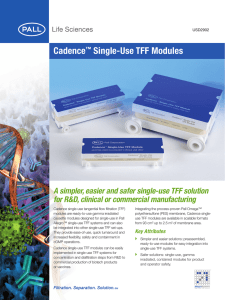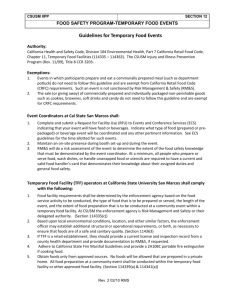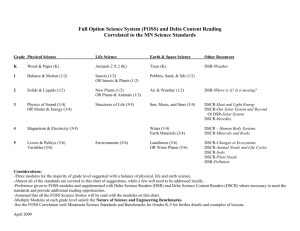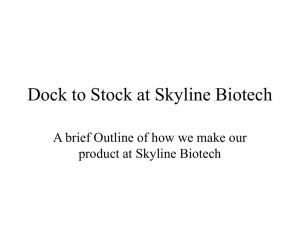Application Note Allegro Single-Use TFF System Integrating Cadence
advertisement
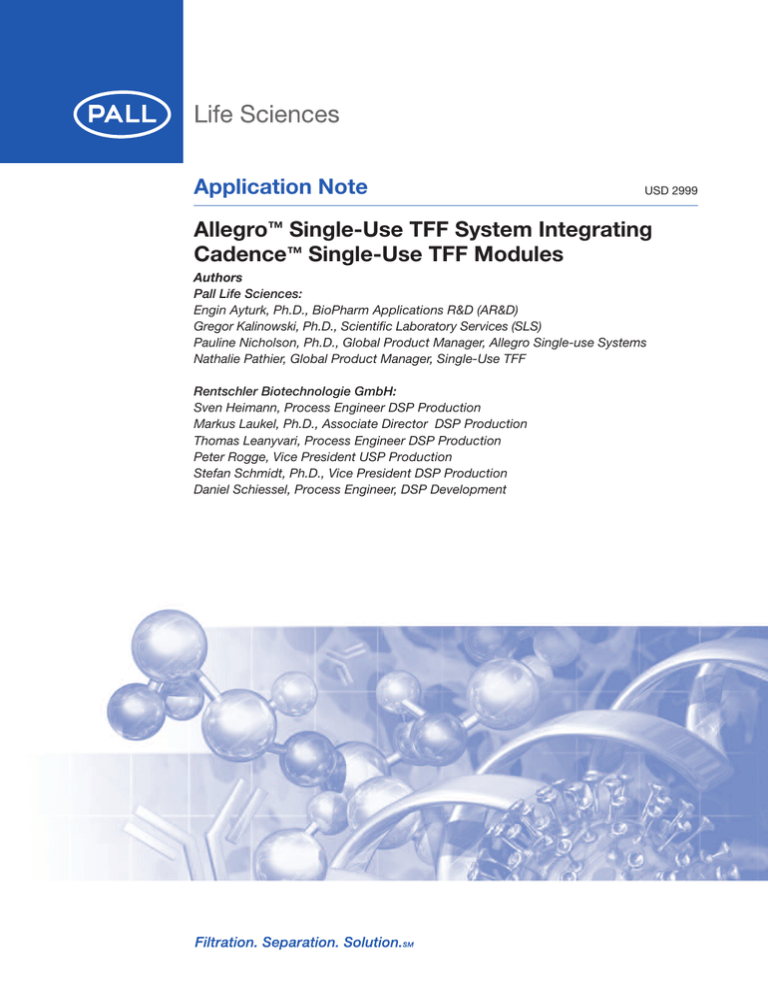
Application Note USD 2999 Allegro™ Single-Use TFF System Integrating Cadence™ Single-Use TFF Modules Authors Pall Life Sciences: Engin Ayturk, Ph.D., BioPharm Applications R&D (AR&D) Gregor Kalinowski, Ph.D., Scientific Laboratory Services (SLS) Pauline Nicholson, Ph.D., Global Product Manager, Allegro Single-use Systems Nathalie Pathier, Global Product Manager, Single-Use TFF Rentschler Biotechnologie GmbH: Sven Heimann, Process Engineer DSP Production Markus Laukel, Ph.D., Associate Director DSP Production Thomas Leanyvari, Process Engineer DSP Production Peter Rogge, Vice President USP Production Stefan Schmidt, Ph.D., Vice President DSP Production Daniel Schiessel, Process Engineer, DSP Development Table of Contents Abstract/Summary ...........................................................................................................................................3 1. Introduction ..................................................................................................................................................3 2. Experimental ................................................................................................................................................4 2.1 Materials, Equipment and Methods..........................................................................................................4 2.1.1 Feedstock ....................................................................................................................................4 2.1.2 TFF Consumables Breakdown per Test ..........................................................................................4 2.1.3 Allegro Single-use TFF System ......................................................................................................5 2.2 Test Method Summary ............................................................................................................................6 3. Results and Discussion..............................................................................................................................7 3.1 Assembly, Installation and Systems Integration ........................................................................................7 3.2 Minimum Working Volume ......................................................................................................................7 3.3 Pre-use Conditioning ..............................................................................................................................7 3.3.1 TOC and Conductivity Trends ........................................................................................................7 3.3.2 Endotoxin and Bioburden Analysis ................................................................................................8 3.4 Performance Evaluation ..........................................................................................................................9 3.4.1 Process Optimization and Benchmark ..........................................................................................9 3.4.2 Comparability, Scalability and Reproducibility of Test Results..........................................................9 3.4.3 Product Recovery ........................................................................................................................11 3.5 Post-Use Decontamination and Disassembly ........................................................................................12 4. Conclusions................................................................................................................................................12 5. Acknowledgements ...................................................................................................................................12 6. References .................................................................................................................................................13 2 Abstract/Summary Performance evaluation of Pall Cadence™ Single-Use Tangential Flow Filtration (SUTFF) modules with Omega™ polyethersulfone membrane have been conducted in collaboration with Rentschler Biotechnologie GmbH. Focus of these tests was to assess the comparative performances of the SUTFF modules against regular Pall Omega T-Series cassettes, and to evaluate the compatibility and usability features with disposable flow paths when integrated into the Allegro™ single-use TFF system. Further parameters investigated were working volume, water for injection (WFI) flush requirements, product recovery, installation and ease of use. Performance evaluation tests conducted at a transmembrane pressure of 1 bar and varying feed channel pressure drops or Delta P (0.5 – 2 bar) over the concentration range of 10 – 100 g L-1 monoclonal antibody product confirmed reproducible (0.4 – 6.9 %) and scalable flux performance (4 - 11 %) and comparable product recoveries between 0.5 m2 Cadence SUTFF modules and 186 cm2 standard Omega T-Series TFF cassettes. Furthermore, integrating gamma-irradiated Cadence SUTFF modules into Rentschler’s existing Allegro™ singleuse TFF system with the utilization of gamma-irradiated ½ in. flow paths resulted in minimal and/or negligible total organic carbon (< 1 ppm) and endotoxin values (<0.01 EU mL-1) when run under recommended operating conditions, achieved within low WFI flush-out volumes. In addition, the absence of detectable bioburden suggested that the sanitization and post-sanitization WFI flush steps could therefore be eliminated from the pre-use conditioning protocol for additional cost savings realized in terms of buffer volume requirements, preparation time and associated labor, when compared to conventional TFF cassettes. 1. Introduction Single-use technology is widely accepted in bioprocessing, with key benefits being the elimination of cross contamination and cleaning, and greater flexibility in manufacturing. Tangential Flow Filtration (TFF) is more complex than many other unit operations for which single-use approaches have been adopted. The product is recirculated during its concentration and key parameters such as the transmembrane pressure, the differential pressure (Delta P) and the recirculation flow rate are controlled and monitored. In addition, the system working volume and hold-up volume are key to ensuring optimal product recovery. The Allegro Single-Use TFF (SUTFF) system is an automated system designed for the ultrafiltration and the diafiltration of proteins, recombinant molecules, potent biological and cytotoxic drugs, and vaccines [1]. This system integrates a fully disposable flowpath with all the sensors required to run and control the TFF process. The flowpath sub-sets are delivered gamma-irradiated. During this study, Rentschler’s customized Allegro single-use TFF system was tested in conjunction with Pall Cadence single-use TFF modules with Omega polyethersulfone (PES) membrane. These modules are pre-assembled, pre-flushed and gamma irradiated modules, providing ease-of-use and readiness of use compared to standard TFF cassettes used in a single-use mode. The tests were performed on a monoclonal antibody (mAb) solution and the main objectives of this study were: • Evaluate comparative performances of Cadence single-use TFF modules (i.e., flux, product recovery, etc.) against standard Omega T-Series cassettes. • Assess installation, assembly and ease-of-use features of the Cadence SUTFF modules integrated in the Allegro SUTFF system utilizing ½ in. gamma-irradiated flow paths. www.pall.com/biopharm 3 2. Experimental Pall Cadence SUTFF modules with 30 kDa Omega membrane (Figure 1[b]) were tested in 0.5 m2 formats. The tests were conducted in duplicate in combination with a ½ in. single-use flow path in Rentschler’s Allegro single-use TFF system. Figure 1 [a] Cadence single-use TFF modules [b] Cadence SUTFF module with 0.5 m2 membrane area. [a] [b] Preliminary process characterization for the mAb product, which was established as the performance benchmark for the SUTFF modules evaluated in this study, was conducted by Rentschler with a Pall Centramate™ T-Series cassette (186 cm2) with Omega membrane (Part Number OS030T02). Main parameters investigated in this study consisted of an operational window of system pressure and cross-flow flux (CFF), permeate flux, product recovery, assembly and ease-of-use attributes. Additional data was collected for the assessment of WFI flush performance, quantitative evaluation of total organic carbon (TOC), endotoxins, and bioburden levels, as well as the estimation of minimum working volume for the different installations. Details of materials and consumables breakdown per test, utilized equipment and followed methodology are discussed next. 2.1 Materials, Equipment and Methods 2.1.1 Feedstock The feedstock used for the SUTFF feasibility tests is a mAb product. Product characteristics are considered representative for typical feed materials processed in TFF unit operations. The tests were planned according to a mAb standard production (final concentration drug substance between 10 and 80 g L-1). The process characterization for the product and the generation of process development (PD) data was conducted with a Pall Omega membrane Centramate T-Series cassette (OS030T02). 2.1.2 TFF Consumables Breakdown per Test • Pall Omega membrane Centramate T-Series cassette – 186 cm2 (OS030T02) – Test series conducted in-house by Rentschler on ÄKTAcrossflow* TFF system (GE Healthcare) • Cadence Single-use TFF module #1 - 0.5 m2 (30 kDa) – gamma irradiated – ½ in. manifold – gamma irradiated – 50 L disposable biocontainer – Installation: performed under laminar flow to accommodate the single-use module and assembly of subsets – Test setup: Pall Allegro Single-use TFF system 4 • Cadence Single-use TFF module #2 - 0.5 m2 (30 kDa) – gamma irradiated – ½ in. manifold – gamma irradiated – 50 L disposable biocontainer – Installation: performed under clean room (class D) conditions to accommodate single-use module and assembly of subsets – Test Setup: Pall Allegro single-use TFF system 2.1.3 Allegro Single-use TFF System The Allegro single-use TFF System, shown in Figure 2, utilized for the tests is owned by Rentschler [2], with features and key attributes summarized in Table 1. Figure 2 Test Setup: Rentschler’s Allegro single-use TFF system (Photo courtesy of Rentschler Biotechnologie GmbH). Table 1 Features and key attributes of Rentschler’s Allegro SUTFF system Features Key Attributes Automated Recipe control ½ in. tubing 1000 L h-1 feed flow 0.5 - 2.5 m2 area Good engineering design Open Architecture Ease of use Ease of access to components Gamma irradiated manifolds The system is equipped with ½ in. flow path manifolds as shown in Figure 3 [a] and [b]. The installation of the 0.5 m2 Cadence SUTFF module into the system holder is also shown in Figure 4. Figure 3 SUTFF Manifolds [a] open architecture flow path and [b] manifold design. [a] [b] www.pall.com/biopharm 5 Figure 4 Installation of Cadence SUTFF module into the holder in the Allegro system. 2.2 Test Method Summary Test protocol followed for the performance evaluation of Cadence SUTFF modules is summarized as follows: • Installation – Assembly under laminar flow hood - for module #1 – Assembly under clean room (Class D) – for module #2 • Pre-use Conditioning – Determination of feed/retentate hold up volume with WFI via feed biocontainer weight drop utilizing Allegro system load cells. – WFI Flush (Samples for TOC and conductivity, endotoxins and bioburden) – SUTFF module integrity test – Sanitization with 0.5 N NaOH – Buffer equilibration (Sample for endotoxins and bioburden) • Optimization and Processing – Delta P excursion at constant TMP of 1 bar to simulate variation in cross-flow flux (CFF in L m-2 h-1) at product feed concentrations of 10, 20, 40 and 80 g L-1. • Post-use Conditioning – Product recovery – no flush – by gravity and pumping through recovery line – Decontamination with 0.5 N NaOH – WFI Flush – Disassembly and disposal The recommended flush-out volumes for SUTFF modules are a minimum of 20 L m-2 (2 L ft-2) deionized (DI) water to waste until a desired TOC, conductivity or neutral pH is achieved. Also note that the actual required volumes might vary, depending on the application requirements. 6 3. Results and Discussion 3.1 Assembly, Installation and Systems Integration Assembly and installation of Cadence SUTFF modules into the Allegro SUTFF system requires manual compression at a nominal torque setting of 900 in-lbs (102 N m) in the system holder. Installation and assembly of the ½ in. flow path with gamma-irradiated SUTFF modules was carried out according to both laminar flow hood assembly and Class D clean room protocols. During system integration the pre-assembled Cadence SUTFF modules provide improved handling, compared to the integration of conventional TFF cassettes, gaskets and single-use distribution plates. Featuring a containment design, supplied pre-flushed and stored in water, the SUTFF modules enhance operator safety. 3.2 Minimum Working Volume The system minimum working volume consists of the volume in the feed/retentate loop, plus the minimum volume in the retentate biocontainer before the system draws air into the loop. In correspondence to the Allegro SUTFF system specification, a minimum working volume of <0.7 L, was confirmed for both tests conducted with 0.5 m2 Cadence Single-use TFF modules in combination with a ½ in. single-use flow path. As summarized in Table 2, system minimum working volume estimate was based on the measurement of the weight difference on the Allegro SUTFF system load cells. Minimum working volume is of great importance to achieve high protein recovery and process yields. Table 2 Minimum working volume during two replicates 3.3 0.5 m2 SUTFF Module #1 #2 Feed/Retentate Hold up [L] Minimum Retentate Biocontainer Volume [L] (for a 50 L Biocontainer) Minimum Working Volume [L] 0.45 0.11 0.54 0.12 0.56 0.66 Pre-use Conditioning 3.3.1 TOC and Conductivity Trends Cadence single-use TFF modules with Omega membrane are delivered pre-flushed, stored in water and gamma irradiated. They can be considered as ready to use. In order to better assess the effectiveness of the flush-out performance, the Cadence single-use TFF modules were assayed for TOC and conductivity of the flush media (WFI) for the initial flush. Flush-out data for the Cadence single-use TFF module #2 (0.5 m2) operated under recommended flush-out conditions, resulted in low TOC values (<1 ppm) at low flush volumes (<20 L m-2). TOC flush-out curve with subsequent conductivity trends for the 0.5 m2 Single-use TFF module #2 is shown in Figure 5. www.pall.com/biopharm 7 Figure 5 SUTFF flush-out curve with TOC (left y-axis) and conductivity (right y-axis) trends. Single-Use TFF Modul e # 2 - 0.5 m2 Module 5 TOC TOC [mg L -1] 6 Retentate T OC TOC TOC Permeate T OC Conductivity Retentate Conductiv ity Permeate Conductiv Conductivity ityy 4 5 4 3 3 2 2 1 1 0 0 0 3.3.2 Conductivity [µS cm-1] 6 10 20 30 WFI Flush V olume [L m-2] Volume o 40 50 Endotoxin and Bioburden Analysis In addition to the TOC and conductivity testing, Cadence SUTFF modules were further assayed for endotoxin levels and bioburden for the initial and post-sanitization flush. As summarized in Table 3, samples from the SUTFF system integrating singleuse TFF modules showed no bioburden and the endotoxin levels were ≤0.01 EU mL-1 without pre-use sanitization. Thus a pre-use sanitization step for gamma irradiated single-use TFF modules might not be required, if the user’s processing requirements are met. This will save time, sanitization solutions and shorten the turnaround times for TFF processes utilizing Pall single-use TFF modules. The modified pre-use conditioning steps with the utilization of SUTFF modules are depicted in Figure 6. Table 3 Endotoxin and bioburden data before and after pre-use sanitization SUTFF 0.5 m2 Module #1 Endotoxin [EU mL ] Bioburden [cfu mL-1] -1 Endotoxin [EU mL ] Bioburden [cfu mL-1] -1 8 Before Sanitization After Sanitization Retentate Permeate Retentate Permeate < 0.01 0 < 0.01 0 < 0.10 0 < 0.10 0 SUTFF 0.5 m2 Module #2 Before Sanitization After Sanitization Retentate Permeate Retentate Permeate 0.01 0 < 0.01 0 < 0.10 0 < 0.10 0 Figure 6 Steps for pre-use conditioning Cadence single-use TFF modules with Omega membrane. Install Modules Flush Step 1 Step 2 Step 3 Flush Determine Hold-up Volume Integrity Test Santitization Step 4 Buffer Conditioning Optimization or Processing Mode Flush Optional After confirming system and module integrity, conducted at a feed pressure of 2 barg (30 psig), pre-use conditioning of the modules was completed via buffer conditioning for a total duration of 15 - 30 minutes. 3.4 Performance Evaluation 3.4.1 Process Optimization and Benchmark Performance evaluation consisted of generating a control experiment adopting Rentschler’s process optimization protocol, which assesses the impact of cross-flow for a constant TMP processing of the mAb feedstock between 10 and 100 g/L. In this respect, benchmark data for standard cassette performance was generated with a Pall Omega membrane Centramate T-Series cassette (OS030T02, 186 cm2) with the same mAb solution utilized for the SUTFF tests at the 0.5 m2 scale. Permeate flux vs. concentration at constant TMP of 1 bar and varying Delta P to simulate the impact of cross-flow on process flux is shown in Table 4. Table 4 Permeate flux data for Pall Omega membrane Centramate cassette (OS030T02) Concentration [g L-1] Delta P 2.0 bar Delta P 1.5 bar Delta P 1.0 bar Delta P 0.5 bar 3.4.2 10.0 20.0 40.2 60.2 80.1 100.2 157.9 145.8 129.4 102.6 107.0 99.2 86.9 67.2 60.9 54.8 46.3 33.8 34.4 30.8 25.9 17.9 20.1 17.7 14.4 10.2 11.7 10.3 8.7 6.5 Flux [L m-2 h-1] Comparability, Scalability and Reproducibility of Test Results Performance evaluation of Cadence SUTFF modules integrated into Allegro SUTFF system consisted of generating a performance map with similar process parameters (1 bar TMP at various Delta P set-points) in order to benchmark against the standard cassette data discussed in Section 3.3.1. As shown in Figure 7, test data for 0.5 m2 Cadence SUTFF modules showed excellent performance, comparable to standard Omega T-series cassettes tested at smaller scale. www.pall.com/biopharm 9 Figure 7 SUTFF performance evaluation [a] module #1 and [b] module #2. [a] Process Optimization and Performance Evaluat ion Evaluation with 0.5 m2 Single-Use TFF Module #1 160 Delta P 0.5 bar (TMP=1 bar) Delta P 1.0 bar (TMP=1 bar) Delta P 1.5 bar (TMP=1 bar) Delta P 2.0 bar (TMP=1 bar) Flux [L [L m-2 h-1] 140 120 100 80 60 40 20 0 1 10 100 Concentration [g L-1] Process Optimization and Performance Evaluat ion Evaluation with 0.5 m2 Single-Use TFF Module #2 [b] 160 Delta P 0.5 bar (TMP=1 bar) Delta P 1.0 bar (TMP=1 bar) Delta P 1.5 bar (TMP=1 bar) Delta P 2.0 bar (TMP=1 bar) 140 Flux [[L L m-2 h-1] 1000 120 100 80 60 40 20 0 1 10 100 1000 Concentration [g L-1] At a given Delta P set-point, the average permeate flux between the control cassette and the SUTFF modules during concentration from 10 to 80 g L-1, differed between 4-11% for SUTFF module #1 and 4-8 % for module #2, favouring SUTFF modules. While the minor difference in performance was attributed to the changes in CFF as feed was concentrated, the performance data plotted in Figure 7 and summarized in Table 5, not only showed comparable performance but also confirmed 27x scalability (186 cm2 to 0.5 m2) to that of standard Omega T-Series cassettes. Table 5 Permeate flux data for Pall 0.5 m2 Single-Use TFF modules #1 and #2 SUTFF Module #1 SUTFF Module #2 Concentration [g L ] Concentration [g L-1] -1 Delta P 2.0 bar Delta P 1.5 bar Delta P 1.0 bar Delta P 0.5 bar 10 11.0 20.9 40.7 79.5 132.0 115.2 108.0 92.4 98.4 86.4 79.2 63.6 61.2 54.0 46.8 36.0 24.0 21.6 18.0 13.2 Flux [L m-2 h-1] 10.4 21.0 41.3 83.6 135.6 129.6 112.8 93.6 99.6 91.2 76.8 61.2 58.8 54.0 45.6 32.4 22.8 21.6 19.2 13.2 It is noteworthy to mention that the pressure excursions for different concentration profiles were performed stepwise from low to high concentrations. In this respect, a slight increase of the product temperature over processing time might have occurred and could have also contributed to the observed increase in permeate flux for the higher feed concentrations. During these experiments, temperature monitoring was not included as a parameter. Regardless of minor influential factors, the variability in permeate flux between the control run and the SUTFF modules was minimal. As shown in Figure 8, processing of 0.5 m2 Cadence SUTFF modules at constant TMP of 1 bar and various Delta P resulted in identical performance, thus excellent reproducibility, with minimal variation of 0.4 – 6.9%, over the entire Delta P set-points and concentration range tested. Figure 8 Process reproducibility with 0.5 m2 SUTFF modules at [a] Delta P of 0.5 bar (constant TMP of 1 bar) [b] Delta P of 1 bar (constant TMP of 1 bar) [c] Delta P of 1.5 bar (constant TMP of 1 bar) and [d] Delta P of 2 bar (constant TMP of 1 bar). Process Reproducibility with 0.5 m2 Single-Use TFF Modules Delta P 0.5 bar (module #1) Delta P 0.5 bar (module #2) 1 Flux [L [L m-2 h-1] 3.4.3 1000 Process Reproducibility with 0.5 m2 Single-Use TFF Modules [c] 160 140 120 100 80 60 40 20 0 10 100 Concentrati Concentration on [g L-1] Flux [[L L m-2 h-1] 160 140 120 100 80 60 40 20 0 100 10 Concentrati on [g L-1] Concentration 160 140 120 100 80 60 40 20 0 Delta P 1.0 bar (module #1) Delta P 1.0 bar (module #2) 1 10 100 Concentration Concentration [g L-1] [d] Delta P 1.5 bar (module #1) Delta P 1.5 bar (module #2) 1 Process Reproducibility with 0.5 m2 Single-Use TFF Modules [b] Flux [L [L m-2 h-1] Flux [[L L m-2 h-1] [a] 1000 1000 Process Reproducibility with 0.5 m2 Single-Use TFF Modules 160 140 120 100 80 60 40 20 0 1 Delta P 2.0 bar (module #1) Delta P 2.0 bar (module #2) 10 100 Concentrati Concentration on [g L-1] 1000 Product Recovery Product recovery was carried out by gravity drain via the low point recovery valve of the system and subsequent pumping through the drain valve. No additional recovery flush was performed. As shown in Table 6, the product recovery rates achieved for 0.5 m2 SUTFF modules were >92 %, which was comparable to the values achievable with standard cassettes. Product recovery could be further improved via a buffer chase for retentate displacement at the expense of retentate pool dilution. Table 6 Product recovery for Pall 0.5 m2 single-use TFF modules SUTFF Module and manifold tested [%] 0.5 m Module #1 0.5 m2 Module #2 92.5 93.1 2 www.pall.com/biopharm 11 3.5 Post-Use Decontamination and Disassembly Upon completion of the processing and product recovery steps, the Cadence single-use TFF module and system flow path should be discarded per local codes or standards. This may include autoclaving or incinerating the disposable products (module and tubing). On the other hand, post-use decontamination protocols may change depending on the end-user application and containment requirements and TFF system design. In this study, the post-use decontamination or inactivation of the whole TFF system was carried out prior to disassembly via 1 N NaOH recirculation and subsequent DI Water flush-out. Disassembly of the single-use TFF flow path including the SUTFF modules from the TFF skid to allow a safe post-use containment has been demonstrated. 4. Conclusions Integration of Cadence single-use TFF modules into Allegro single-use system equipped with disposable flow path was successfully demonstrated during testing at Rentschler Biotechnologie GmbH (Laupheim, Germany). Performance evaluation of 0.5 m2 Cadence single-use TFF modules over a concentration range of 10 – 80 g L-1, during constant TMP processing at different Delta P set points, resulted in an excellent performance that was comparable to that of standard Omega T series cassettes. Benchmark against 186 cm2 standard cassettes, further confirmed scalable performance for the processing of same mAb feedstock. In addition, the Cadence modules performance map generated over the entire Delta P set-points and concentration range, was reproducible with minimal variation of 0.4 – 6.9 %, indicating process robustness and reliable operation. Product recovery for SUTFF modules was carried out by gravity drain only via the low point recovery valve of the system and resulted in comparable yields to typical values achieved in the SUTFF system with regular TFF cassettes. Data for 0.5 m² Cadence SUTFF modules indicate low TOC values even with low flush volumes. Samples from the SUTFF system integrating gamma-irradiated SUTFF modules showed no bioburden and endotoxin levels ≤ 0.01 EU mL-1 without pre-use sanitization. This supports elimination of the pre-use sanitization step. Such an approach could offer significant savings through reduction in buffer/sanitant volumes and reduces direct labor hours required for solution preparation, and shortens the processing time for TFF unit operation, with the utilization of Cadence single-use TFF modules. Time saving would be in the range of 2 - 4 hours. Rentschler typically assembles regular TFF cassettes and conducts pre-sanitization one day prior to processing their product. Potentially, all processing steps could be performed on the same day with SUTFF modules, which could also improve overall productivity and resource allocation. Easy assembly and sterile connections of Cadence single-use TFF modules to single-use flow path under a laminar flow hood has been demonstrated. Based on bioburden data gathered, assembly under clean room (class D) conditions might be sufficient for processing and allow bioburden control. Further data would need to be collected and a risk assessment performed by Rentschler would be required to finalize the decision for the further simplification of pre-use conditioning steps. Finally, disassembly of the single-use TFF flow path including the Cadence single-use modules (post-use containment) has been demonstrated. This would be a benefit in applications were the operator safety is a concern post-use (e.g. with cytotoxic or some virus based products). 5. Acknowledgements Authors gratefully acknowledge the support provided by the Rentschler team and Pall TFF Product Development (Rob Ieraci and Rachel Forman) and PASS Engineering team, (Steve Crouch, Aymen El-Ghezal and Zander Hack). 12 6. References 1. Nicholson, Pauline and Storm, Erik. "Single-Use Tangential Flow Filtration in Bioprocessing". BioProcess International (2011). 2. Laukel, Markus; Rogge, Peter and Dudziak Gregor. “Disposable Downstream Processing for Clinical Manufacturing”. BioProcess International (2011). About Rentschler: Rentschler is a biopharmaceutical contract manufacturer with over 35 years proven track record. As an independent and family-owned company headquartered in Germany our full-service customized solutions range from supporting drug candidate selection by our TurboCell platform, as well as cell line and process development over production to analytics and fill & finish. Focused on the utilization of mammalian cell lines, our experience covers the development and production of recombinant proteins such as cytokines, enzymes, monoclonal antibodies and fusion proteins in compliance with international GMP standards (EMA/FDA). Our project management is characterized by proactive and responsive communication. Successful projects and long lasting client relationships show that we are reliable and experienced. State-of-the-art facilities and services comprising batch, fed-batch and perfusion processes allow the production of material for clinical phases and commercial supplies. Our GMP manufacturing comprises stainless steel bioreactors with total volume from 30 L up to 3,500 L ensuring the flexible and customized production and delivery of material. As a cost-efficient and fast manufacturing alternative, Rentschler provides also single-use bioreactors with volumes of up to 1,000 L. Our Fill & Finish facility offers aseptic liquid filling in vials (100 up to 80,000 units), lyophilization (100 up to 70,000 units) and aseptic liquid filling of prefilled syringes (100 to 15,000 units). Our experience with international regulatory affairs and authorities complete our services. In summary, our full-service concept allows us to react with flexibility on the individual project requirements of our clients. Visit us on the Web at www.pall.com/allegro E-mail us at allegro@pall.com Corporate Headquarters Port Washington, NY, USA +1.800.717.7255 toll free (USA) +1.516.484.5400 phone biopharm@pall.com e-mail International Offices Pall Corporation has offices and plants throughout the world in locations such as: Argentina, Australia, Austria, Belgium, Brazil, Canada, China, France, Germany, India, Indonesia, Ireland, Italy, Japan, Korea, Malaysia, Mexico, the Netherlands, New Zealand, Norway, Poland, Puerto Rico, Russia, Singapore, South Africa, Spain, Sweden, Switzerland, Taiwan, Thailand, the United Kingdom, the United States, and Venezuela. Distributors in all major industrial areas of the world. To locate the Pall office or distributor nearest you, visit www.pall.com/contact. European Headquarters Fribourg, Switzerland +41 (0)26 350 53 00 phone LifeSciences.EU@pall.com e-mail The information provided in this literature was reviewed for accuracy at the time of publication. Product data may be subject to change without notice. For current information consult your local Pall distributor or contact Pall directly. Asia-Pacific Headquarters Singapore +65 6389 6500 phone sgcustomerservice@pall.com e-mail © 2014, Pall Corporation. Pall, , Allegro, Cadence and Omega are trademarks of Pall Corporation. ® indicates a trademark registered in the USA and TM indicates a common law trademark. Filtration.Separation.Solution. is a service mark of Pall Corporation. ◆ÄKTAcrossflow is a trademark of GE Healthcare. 9/14, PDF, GN14-6037 USD2999
